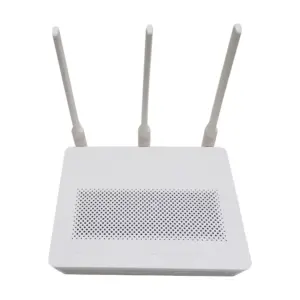Thank you for reading this article, I will introduce you to the SFP-10G-ZR optical transceiver, which is a high-speed optical fiber transmission solution that plays an important role in optical fiber communications. Whether it is remote data center interconnection or cross-regional network connection, SFP-10G-ZR optical transceiver is a key component, providing reliable, high-speed data transmission solutions.
Overview of SFP-10G-ZR optical transceiver
SFP-10G-ZR is an optical module, also known as an optical transceiver. It is a high-performance fiber optic transmission solution for transmitting data in fiber optic communications. The following is an overview of the SFP-10G-ZR optical transceiver and its role in fiber optic communications:
1 Overview:
- SFP-10G-ZR is a small packaged optical module that adopts the SFP (Small Form-Factor Pluggable) interface standard. It has high-speed transmission capabilities and high reliability, and is widely used in data communications and network fields.
- "10G" means that its transmission rate is 10 Gbps (gigabits per second), and "ZR" means that it is a long-distance transmission optical module that can support longer transmission distances.
Features of SFP-10G-ZR optical transceiver
The SFP-10G-ZR optical transceiver has the following features and performance indicators:
Features:
- Transmission rate: SFP-10G-ZR optical transceiver supports a high-speed transmission rate of 10 Gbps (gigabits per second), which is suitable for large-capacity data transmission and high bandwidth requirements.
- Transmission distance: It is an optical transceiver for long-distance transmission. It can usually support transmission distances of tens of kilometers and is suitable for long-distance data transmission requirements.
- Fiber type: SFP-10G-ZR optical transceiver usually supports single-mode fiber (Single-Mode Fiber, SMF) type for long-distance transmission, but is not suitable for multi-mode fiber (Multi-Mode Fiber, MMF).
- Interface type: It adopts SFP (Small Form-Factor Pluggable) interface standard and has hot-swappable function for easy installation and replacement.
Performance:
- Optical power: The optical power output by the SFP-10G-ZR optical transceiver at the transmit end is usually between 0 and 5 dBm, and the specific value depends on the manufacturer and product specifications.
- Sensitivity: At the receiving end, the sensitivity of the SFP-10G-ZR optical transceiver indicates its sensitivity to the input optical signal. Typical sensitivity range is usually between -24 and -7 dBm.
- Wavelength range: The operating wavelength of the SFP-10G-ZR optical transceiver is usually around 1550 nanometers (nm). The specific wavelength range may be stated in the manufacturer’s specifications, with a typical range being 1528 nm to 1565 nm.
These features and performance indicators make the SFP-10G-ZR optical transceiver a suitable solution for long-distance, high-speed optical fiber transmission. It is widely used in scenarios such as data centers, long-distance communications, enterprise networks, and telecommunications networks to meet high bandwidth and reliability requirements. In actual applications, specific features and performance indicators may vary. It is recommended to understand and select in detail based on the specifications and technical information provided by the supplier.
Application scenarios of SFP-10G-ZR optical transceiver
SFP-10G-ZR optical transceiver has a wide range of applications in long-distance data transmission scenarios, and is especially suitable for requirements that require long-distance transmission and high-speed data transmission. The following are some actual SFP-10G-ZR optical transceiver application cases:
-
Remote data center interconnection: When multiple data centers are located in different geographical locations, the SFP-10G-ZR optical transceiver can be used to establish high-speed connections between remote data centers. It is capable of carrying large-capacity data transmission, ensuring fast and reliable communication between data centers.
-
Cross-regional network connection: In network deployments across different regions, SFP-10G-ZR optical transceivers can be used to connect network devices in various regions to achieve cross-regional data transmission. For example, network connections that span states, countries, or continents require data transmission capabilities and stability over long distances.
-
WAN connection: The SFP-10G-ZR optical transceiver can be used to build a Wide Area Network (WAN) connection to connect offices, branches or partner organizations distributed in different locations. It provides high-speed, reliable data transmission for wide area networks, supporting remote offices and distributed work environments.
-
Enterprise-level network expansion: For large-scale enterprise networks, SFP-10G-ZR optical transceivers can be used to expand the transmission distance and bandwidth of the network. It can connect network devices located on different floors, buildings or campuses, supporting high-speed data transmission and reliable communications.
-
Telecom network: In the network of telecom operators, the SFP-10G-ZR optical transceiver can be used to connect optical transmission equipment to achieve long-distance optical fiber transmission and transmit high-speed data. It plays a key role in telecommunications infrastructure, supporting applications such as broadband access, fiber optic backbones and data center interconnection.
SFP-10G-ZR optical transceiver purchasing tips
When selecting SFP-10G-ZR optical transceiver, the following points can be used as a reference:
-
Supplier reliability: Choose a supplier or manufacturer with a good reputation and reliability. This ensures product quality and performance, as well as reliable after-sales support and service.
-
Compatibility: Make sure the selected SFP-10G-ZR optical transceiver is compatible with your device. It is important to verify the compatibility of the optical transceiver with your fiber optic switch, router, or other network equipment. Review the device’s technical specifications and compatibility list to ensure that the optical transceiver will work properly with your device.
-
Price: Price is an important factor to consider when purchasing optical transceivers. Compare price and performance between different suppliers to find the best value for money. However, it’s not just about the price, but also making sure the quality and performance of the product will meet your needs.
In terms of compatibility and interoperability, the compatibility of the SFP-10G-ZR optical transceiver with other devices is very important. Here are a few reasons why compatibility and interoperability are crucial:
-
Equipment interconnection: SFP-10G-ZR optical transceiver is usually used to connect fiber optic switches, routers or other network equipment. Ensure the interoperability between optical transceivers and these devices to work properly and achieve stable data transmission and communication.
-
Network topology: Various devices and vendors may exist in a network environment. Ensure that the SFP-10G-ZR optical transceiver is compatible with equipment from different manufacturers, allowing you to more flexibly build and expand network topologies to meet specific needs.
-
Future upgrades and replacements: Compatibility is very important when it comes to network upgrades or device replacements. If the SFP-10G-ZR optical transceiver is compatible with a variety of devices, you can more easily upgrade or replace the device without having to replace the entire network infrastructure.
Deployment and configuration of SFP-10G-ZR optical transceiver
Here are some recommendations and considerations when deploying and configuring SFP-10G-ZR optical transceivers:
Deployment strategy:
-
Fiber optic connection planning: Before deploying the SFP-10G-ZR optical transceiver, fiber optic connection planning is necessary. Determine the path, length and connection points of the optical fiber to ensure the quality of the optical fiber and the reliability of the connection.
-
Optical power calibration: When installing and configuring the SFP-10G-ZR optical transceiver, optical power calibration is required. Use an optical power meter to measure the optical power at the transmitter and receiver and make sure it is within the required range. According to the recommendations provided by the manufacturer, adjust the optical power of the transmitter to ensure the sensitivity and transmission quality of the receiver.
-
Link test: After completing the fiber connection, it is necessary to perform a link test. Use a fiber tester or network analyzer to test the link to ensure it is performing as expected and to troubleshoot potential issues.
Configuration options:
-
Fiber type: SFP-10G-ZR optical transceiver is usually suitable for single-mode fiber (Single-Mode Fiber, SMF). Make sure the fiber type selected matches the requirements of the optical transceiver for optimal performance and transmission.
-
Transmission distance setting: Configure the transmission distance setting of the SFP-10G-ZR optical transceiver according to the actual transmission distance requirement. This can be set through the device’s configuration interface or command line interface. Make sure to set the transmission distance to match the actual distance to ensure the transmission quality and stability of the optical signal.
-
Other configuration options: According to actual needs, other options can also be configured, such as adjustment of transmit power, interface rate and protocol settings, etc. These options can be adjusted and configured based on specific device and network requirements.
When deploying and configuring SFP-10G-ZR optical transceivers, it is recommended to follow the specific guidelines and technical documentation provided by the vendor. These guides will provide detailed steps and configuration instructions to ensure proper deployment and configuration and enable high-performance data transfer and communication.
Conclusion:
As a high-speed optical fiber transmission solution, the SFP-10G-ZR optical transceiver plays an important role in the field of optical fiber communications. It supports transmission rates up to 10Gbps and can achieve transmission distances of up to 80 kilometers.
If you are looking for reliable, high-speed fiber optic transmission solutions, consider choosing the SFP-10G-ZR optical transceiver. We offer reliable vendor selection, compatibility guarantees and competitive pricing to help you achieve efficient data communications and superior network performance.
If you are interested in SFP-10G-ZR optical transceiver, please contact us and we will provide you with professional advice and support to help you choose the SFP-10G-ZR optical transceiver solution that suits your needs and achieve excellence data transmission effect.
- How far can SFP 10G ZR go?
- What is the range of 10G ZR?
- What are the different types of 10Gb SFP?
- What is the difference between 10G SFP and 10G SFP+?
- What is the range of SFP ZR?
- Can I use 10G SFP run at 1G?
- Can 10gb SFP run at 2.5 GB?
- Can you use 10G SFP for 1G?
- How do I know which SFP to use?
- How do I know if my SFP is 10G?



